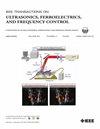软封装对可植入器件PMUTs接收性能的影响。
IF 3.7
2区 工程技术
Q1 ACOUSTICS
IEEE transactions on ultrasonics, ferroelectrics, and frequency control
Pub Date : 2025-07-25
DOI:10.1109/TUFFC.2025.3592740
引用次数: 0
摘要
超声(US)是一种很有前途的无线供电植入式设备的方式,需要封装接收器来确保长期稳定。传统的密封包装往往限制了声音的传播,使聚合物封装成为更合适的选择。本研究探讨了植入级聚合物,热塑性聚氨酯,聚苯乙烯- c和医用级有机硅(MED-1000, MED2-4213)如何影响压电微机械超声换能器(PMUTs)的接收性能。在1 ~ 7 MHz范围内的模拟和测量表明,在nm和μm尺度下,所有被测材料的透射系数都在94%以上,证实了它们的声透明性。结果表明,尽管涂层的pmut在声学上与周围水介质匹配良好,但涂层增加的机械载荷会阻碍膜的运动,减少传递给pmut的能量。模型和实验数据表明,当使用相同厚度的涂层时,较硬的涂层(如聚苯乙烯- c)会导致灵敏度降低。同样地,像MED-1000这样的材料中的残余应力也会降低性能。这些影响仅从声透射测量中并不明显,这强调了在选择封装材料时需要同时评估声学和机械性能。一般来说,较软的材料为PMUT封装提供了出色的声学性能,而较硬的材料必须在较薄的层中应用,以避免损害PMUT的功能。本文章由计算机程序翻译,如有差异,请以英文原文为准。
Effects of Soft Encapsulation on the Receive Performance of PMUTs for Implantable Devices
Ultrasound (US) is a promising modality for wirelessly powering implantable devices, requiring encapsulated receivers to ensure long-term stability. Traditional hermetic packaging often limits acoustic transmission, making polymer-based encapsulation a more suitable alternative. This study investigates how implant-grade polymers, thermoplastic polyurethane (TPU), parylene-C, and medical-grade silicones (MED-1000 and MED2-4213), affect the receive performance of piezoelectric micromachined ultrasonic transducers (PMUTs). Simulations and measurements between 1 and 7 MHz show that all tested materials exhibit transmission coefficients above 94% at nanometer- and micrometer-scale thicknesses, confirming their acoustic transparency. The results show that although coated PMUTs are acoustically well matched with the surrounding water medium, the added mechanical load of the coating can hinder membrane motion and reduce the energy transferred to the PMUTs. Modeling and experimental data demonstrate that stiffer coatings, such as parylene-C, lead to a reduced sensitivity when similar thicknesses are used. Likewise, residual stress in materials like MED-1000 can also degrade the performance. These effects are not evident from acoustic transmission measurements alone, underscoring the need to assess both acoustic and mechanical properties when selecting encapsulation materials. In general, softer materials offer excellent acoustic performance for PMUT encapsulation, while stiffer materials must be applied in thinner layers to avoid impairing PMUT function.
求助全文
通过发布文献求助,成功后即可免费获取论文全文。
去求助
来源期刊
CiteScore
7.70
自引率
16.70%
发文量
583
审稿时长
4.5 months
期刊介绍:
IEEE Transactions on Ultrasonics, Ferroelectrics and Frequency Control includes the theory, technology, materials, and applications relating to: (1) the generation, transmission, and detection of ultrasonic waves and related phenomena; (2) medical ultrasound, including hyperthermia, bioeffects, tissue characterization and imaging; (3) ferroelectric, piezoelectric, and piezomagnetic materials, including crystals, polycrystalline solids, films, polymers, and composites; (4) frequency control, timing and time distribution, including crystal oscillators and other means of classical frequency control, and atomic, molecular and laser frequency control standards. Areas of interest range from fundamental studies to the design and/or applications of devices and systems.

 求助内容:
求助内容: 应助结果提醒方式:
应助结果提醒方式:


